
The Santuario di Maria Santissima della Fontenuova, or Sanctuary of the Holiest Mary of the New Fountain/Spring, is a Marian shrine (church) in piazza Giusti #305 in Monsummano Terme, Tuscany, Italy.

The Santuario di Maria Santissima della Fontenuova, or Sanctuary of the Holiest Mary of the New Fountain/Spring, is a Marian shrine (church) in piazza Giusti #305 in Monsummano Terme, Tuscany, Italy.
Until the 16th century, the region where the church stands was fallow swampy land, only frequented by shepherds. In 9 June 1573, a simple shepherdess, Jacopina Mariotti, lost he flock near here, and prayed to a series of images painted on a small wall at this spot. Putatively a Marian apparition or vision informed the girl of where her flock was found.
This prompted the locals to erect this Marian shrine dedicated to the Madonna of the Planes (Madonna del Piano). Initially this was a small chapel, but putatively increasing miracles, including during a 10 June 1602 service by the town rector Simone Casciani, after a long drought, a spring burst at the spot, this prompted the enlargement of the sanctuary under the patronage of the Grand Duke Ferdinand I de’ Medici in a building designed by Gherardo Mechini.
Construction began on 30 December 1602, in a ceremony attended the court including the prince Cosimo and the wife of Ferdinand, Maria Cristina di Lorena. In 1607, the Grand Duke commissioned erection of a Hostel for pilgrims, adjacent to the Sanctuary. In 1607, Ferdinand donated a bejeweled crown by Cosimo Latini to the sanctuary. A number of artists helped decorate the sanctuary including Bronzino, Cosimo Rosselli, and Domenico Passignano. The ceiling paintings in the nave are an Virgin of the Assumption by Matteo Rosselli; an Annunciation by Gregorio Pagani and a Coronation of the Virgin by Donato Mascagni. The ceiling frieze contains a Veduta di Monsummano Alto (1607) and Prophets, attributed to Vanni da Vellano (1607), while the Sibyls were painted by Giovanni Valeriani. The next register has Saints Sebastian, Jerome, Francis, and Carlo Borrromeo painted by Matteo Rosselli. He also painted an altarpiece depicting the Adoration by the Magi. An altarpiece depicting the Presentation of Mary at the Temple is attributed to Cristofano Allori and the Mary, St Anne and John the Baptist by Pier Dandini. A Crucifix in the sacristy is attributed to Giambologna. Giovanni Mannozzi, also called Giovanni da San Giovanni, frescoed starting in 1630 the 14 lunettes under the loggia. The central lunette has a bust of Maria Cristina flanked by moderately damaged frescoes by Ventura Salimbeni.
The sanctuary is still the goal of pilgrimages (Peregrinatio Mariae) and processions. They crypt, built in 1962 still has the spring coursing through it, feeding an immersion pool meant to heal the sick. In 1962, the Madonna of Fontenova was proclaimed the patron of the diocese of Pescia. In 1974, cardinal Paolo Bertoli, Camarlengo of the Vatican, announced that Pope Paul VI had elevated the sanctuary to a minor basilica. [1]
In the space in front of the church is a Monument to the poet Giuseppe Giusti, sculpted by Cesare Fantacchiotti.

Santa Maria Novella is a church in Florence, Italy, situated opposite, and lending its name to, the city's main railway station. Chronologically, it is the first great basilica in Florence, and is the city's principal Dominican church.
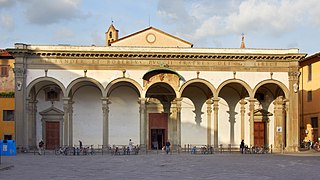
The Basilica della Santissima Annunziata is a Renaissance-style, Catholic minor basilica in Florence, region of Tuscany, Italy. This is considered the mother church of the Servite Order. It is located at the northeastern side of the Piazza Santissima Annunziata near the city center.

Cosimo Rosselli was an Italian painter of the Quattrocento, active mainly in his birthplace of Florence, but also in Pisa earlier in his career and in 1481–82 in the Sistine Chapel in Rome, where he painted some of the large frescoes on the side walls.

Monsummano Terme is an comune located in the Province of Pistoia, Tuscany, central Italy. It is located in the Valdinievole, and is a popular spa resort.

Sant'Anna dei Lombardi,, and also known as Santa Maria di Monte Oliveto, is an ancient church and convent located in piazza Monteoliveto in central Naples, Italy. Across Monteoliveto street from the Fountain in the square is the Renaissance palace of Orsini di Gravina.

Matteo Rosselli was an Italian painter of the late Florentine Counter-Mannerism and early Baroque. He is best known however for his highly populated grand-manner historical paintings.

The Basilica della Santissima Annunziata del Vastato is the Catholic cathedral of Genoa, northern Italy; its decoration employed the major baroque studios and artists in Genoa in the 17th century.

Giovanni da San Giovanni, also known as Giovanni Mannozzi, was an Italian painter of the early Baroque period, active in Florence.

The Basilica of Saint Nicholas of Tolentino is a Roman Catholic church and minor basilica that is part of the Augustinian monastery in the hill-town of Tolentino, province of Macerata, Marche, central Italy. The church is a former cathedral of the Roman Catholic Diocese of Tolentino, suppressed in 1586.

Santa Maria Maddalena dei Pazzi is a Renaissance-style Roman Catholic church and a former convent located in Borgo Pinti in central Florence, Italy.

The Shrine of Santa Maria della Steccata is a Greek-cross design Renaissance church in central Parma, Italy. The name derives from the fence in the church. A Nursing Madonna is enshrined within, crowned on 27 May 1601 by a Marian devotee, Fray Giacomo di Forli of the Capuchin order. Pope Benedict XVI raised the Marian sanctuary to the status of Basilica minor on 9 February 2008.

The Basilica of San Domenico, also known as Basilica Cateriniana, is a basilica church in Siena, Tuscany, Italy, one of the most important in the city. The basilica is an example of Cistercian Gothic style.
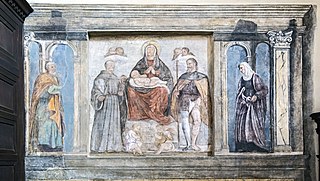
Girolamo Tessari, also called Gerolamo Tessari or Girolamo dal Santo, was an Italian painter, active in a Renaissance style in his native city of Padua.
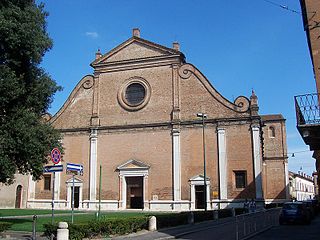
San Francesco is a late-Renaissance, Roman Catholic minor basilica church located on via Terranuova in Ferrara, Emilia-Romagna, Italy.
The Collegiate Church of Santa Maria Assunta is a Gothic church located in Sermoneta, southern Lazio, Italy. The church is often referred to as a cathedral ("cattedrale") but has never been the seat of a bishop. It is dedicated to the Assumption of the Virgin Mary.

The Sanctuary of the Madonna of the Oak or Santuario della Madonna della Querce is a Renaissance-style, Roman Catholic church located about a kilometer from the center of the town of Lucignano, in the region of Tuscany, Italy. The church is in the Roman Catholic Diocese of Arezzo-Cortona-Sansepolcro.

The Basilica of Santa Maria della Quercia is a Renaissance-style, Roman Catholic sanctuary church and minor basilica, about two kilometer outside of the center of Viterbo, on the road to Bagnaia, in the Region of Lazio, Italy.
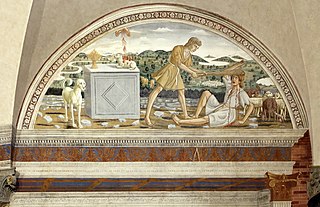
Bernardo di Stefano Rosselli (1450–1526) was an Italian painter active in his native Florence and the surrounding countryside.

The church and convent of the Santissima Annunziata is a Baroque-style, Roman Catholic church located on Piazza de Servi #4, Pistoia, region of Tuscany, Italy. The convent presently functions as a warehouse. The church is down via Laudesi from the San Desiderio, and via Piazza de Servi, From San Giovanni Decollato.
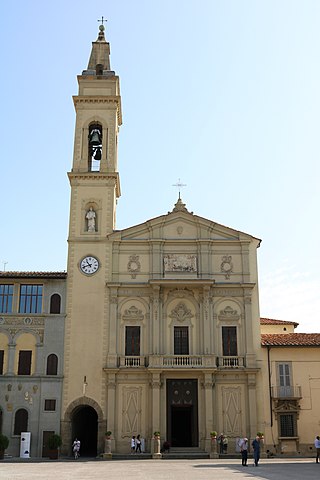
The Insigne Collegiata di San Lorenzo is a church in Piazza Varchi of central Montevarchi, Province of Arezzo, Tuscany, central Italy. Attached to the church is a small museum of sacred art, which includes a reconstructed chapel (tempietto) bedecked with panels by Andrea della Robbia.